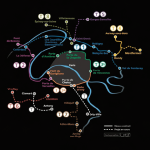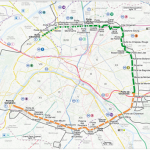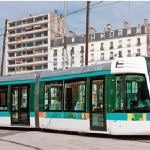The tramway network in Paris area has known a significant
development with the official opening of three tramlines
extensions by the end of 2012:
- 15th November 2012: extension of Tramway line T1 from
Saint-Denis to Asnières-sur-seine-Gennevilliers-Les Courtilles - 19th November 2012: extension of Tramway line T2 from
La Défense to Pont de Bezons - 15th December 2012: extension of Tramway line T3 from
Porte d’Ivry to Porte de la Chapelle
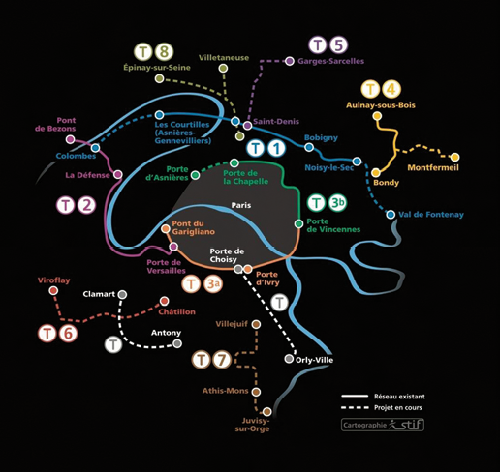
Currently, four tramlines are operating in Ile-de-France region:
T1, T2, T3 and T4. As shown on the following map, the network
will be completed by the commissioning of four other lines by
the end of 2014: T5 (Saint-Denis- Garges-Sarcelles), T6 (Viroflay-
Châtillon), T7 (Villejuif-Athis-Mons), T8 (Saint-Denis-Epinay-surseine-
Villetaneuse). Two other tramlines projects are being
studied (one between Porte de Choisy and Orly-ville and another
one from Antony to Clamart).
The official opening of the Tramway T3 extension, on
15th December 2012, marks a new stage of the emblematic
T3 project, first modern tramway in Paris proper.
The first section of the project, between Pont du Garigliano
and Porte d’Ivry, usually called Boulevards des Maréchaux
Sud, was opened in December 2006.
In early 2009, work began on a 14.5 kilometres (9 miles)
extension from Porte d’Ivry to Porte de la Chapelle. The
extension project was then split into a smaller extension
from Porte d’Ivry to Porte de Vincennes and a separate
tramway line so as to preserve its attractiveness with regards
to patronage and regularity of travel time.
Due to the need of offload at Porte de Vincennes, the T3 has
been divided into two sections called T3a and T3b.
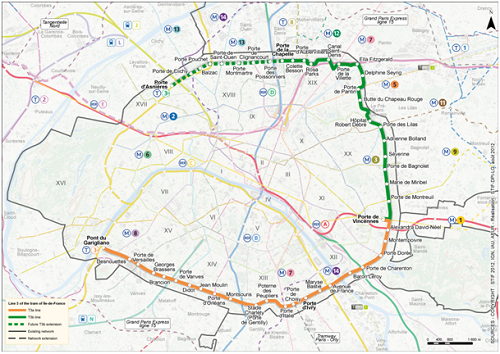
The T3a line connects Boulevard Victor–Pont du Garigliano
Rapid Transit Railway station in the western part of the 15th
district (arrondissement in French) with Porte de Vincennes
metro station in the 12th district. The T3b line connects
Porte de Vincennes to Porte de la Chapelle in the 17th district.
The cost of the T3 project extension is € 652 million. The
financing of the transport project and qualitative layouts are
shared between Paris City Hall and the Regional Council of
Ile-de-France, for € 583 million (73% of the total cost) and
€ 218 million (27%) respectively.
Operated by RATP, the extension of the T3 allows connections
with 2 lines of the RER (Rapid Transit Railway), 9 metro
lines and 44 bus lines. This extension represents 14.5
kilometres for 26 new stations. 170 000 inhabitants and
100 000 jobs are now served.
Key Figures :
- 14.5 kilometres between Porte d’Ivry (15th district)
and Porte de la Chapelle (18th district) - 26 tramway stations
- 5 districts served (13th, 12th,20th,19th and 18th
districts) - 2 adjacent départements concerned (Val-de-Marne
and Seine-Saint-Denis) - 11 municipalities served (Ivry-sur-Seine, Charentonle-
Pont, Saint-Mandé, Vincennes, Montreuil,
Bagnolet, Le Pré Saint-Gervais, Les Lilas, Pantin,
Aubervilliers, Saint-Denis) - 11 metro lines and 2 RER lines (E and C) connecting
- 44 bus lines: 21 Parisian lines, 23 peripheral lines
and several Noctilien lines - 60 Vélib’ stations located within less than 300
meters from each tramway station
The design selected for T3 is the Alstom Citadis 402 which
already runs on the first section of the line. The Citadis is the
most developed tramway model in France (present in 18
cities). It is supplied through an overhead contact line and
offers a capacity of 304 people, including 78 seats. On
board, it is fitted with the very best passenger information
equipment and offer outstanding passenger comfort (air
conditioning and video security systems). The Citadis is also
accessible to all with integral low floor, spacious layouts,
spaces dedicated to wheelchairs and pushchairs.
This vehicle fleet has known a graphic change in comparison
to the Boulevard des Maréchaux Sud section. The STIF livery
and its bright silver colour have been appended onto the top
part of the tramway, as well as the brand logo of the STIF.
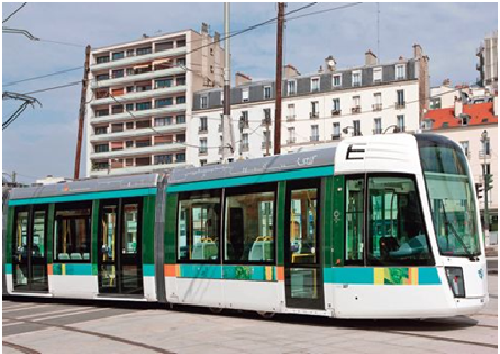
In fact, the STIF finances 100% of the purchase, the renovation
of all the vehicle fleet as well as the operating cost.
The integration of the tramway in public space was designed
carefully. The T3 extension has drawn a new urban reorganization
and contributed to the cities’ development by improving
local services in Paris East area and by reinforcing connections
with adjacent municipalities.
Large pedestrian spaces and cycling lanes have been converted.
Two permanent traffic lanes have been kept for vehicles in each
traffic way. A dedicated-lane tramline where more than 60 000
square metres of turf has been planted contributes to a flowing
and scheduled traffic, which provides passengers with a good
quality of service with a frequency of every 4-5 minutes in peak
hours and every 8 minutes off-peak hours.
The arrival of the T3 also required the achievement of specific
infrastructure. 36 engineering structures had been constructed
or altered on the T3 rail extension project (walls, bridges and
tunnels), including for example, the enlargement of Pont National
and the deletion of Porte de Vitry viaduct in the 13th district.
Moreover, an artistic dimension was included in the project.
About twenty artistic projects were implanted on the tramline
territory, on different sites deemed to be remarkable or symbolic
by their history or sociological characteristics. This global artistic
project served as a link between the five Parisian districts and the eleven adjacent concerned municipalities. It reinforced and
followed the transformation of these public spaces located outside
of Paris City. Financed exclusively by the Paris City Hall for €
11.178 million, artists from all over the world committed themselves
to the project. This artistic thinking was elaborated in
order to improve visibility and comfort in stations. The art works
also contributed to the identification of transport modes and
transit connections.
Bertrand Delanoe, the Mayor of Paris, said: «The T3 line has
enabled a true sewing work with adjacent municipalities. In the
South, more than half of the journeys concern flows between
Paris and adjacent municipalities».
The extension of the T3 participates to a sustainable improvement
of public transport in Paris and Ile-de-France region. The T3
project is still on-going. A new extension of this line to Porte
d’Asnières by 2017 has been submitted to Public Inquiry since 5th
June 2013, date of the first public meeting. The T3 will then stop
at different stations in the 17th and 18th districts but also in the
municipalities of Saint-Denis, Saint-Ouen, Clichy and Levallois.
The growing development of Paris tramway network underlines
an increase of the needs, as the continuous extension of the T3
line shows it. With 8.3 million journeys in public transport every
day, the Ile-de-France region has known an increase of 21 %
within just 10 years. Most journeys in public transport represent
one-fifth of all journeys in the region.
As a consequence, a significant development of public transport
service is supported by the STIF since 2006 with € 505 million
invested to provide additional services, including € 289 million
for the bus and tram networks.
This policy corresponds to the general objectives of the STIF and
the Regional Council of Ile-de-France aiming at supporting development
in Paris-Ile-de-France region by continuing to roll out
metro and tram infrastructure, improving services to existing
stations in the inner suburbs, facilitating and promoting the use
of public transport (increased convenience, regularity across the
entire network and intermodal facilities).
Contact: cyril Aillaud
